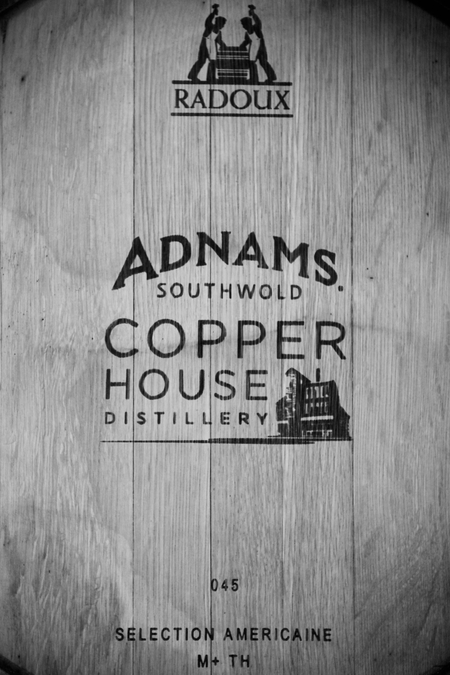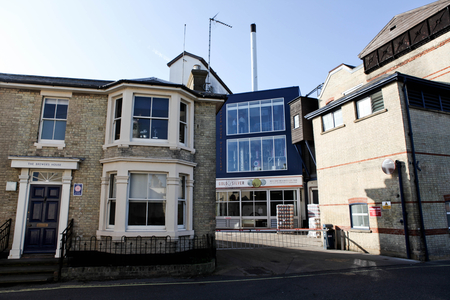Are you a Discerning Drinker?
Join thousands of like-minded professionals and cocktail enthusiasts, receive our weekly newsletters and see pages produced by our community for fellow Discerning Drinkers.

More about Adnams Sole Bay Brewery & Copper House Distillery
Established: 1872
Visitor Policy: Not generally accessible
Tel: +44 1502 727 200
Website: http://adnams.co.uk/
Address
IP18 6JW
Suffolk, England
United Kingdom
SOLE BAY BREW HOUSE
Almost all the malted cereals Adnams uses is grown locally and it has a 40-year contract with East Anglian farmers for grain supply. This is processed by four local maltsters: Simpsons, Boortmalt, Bairds and Crisp.
Although Adnams’ brew house lies within the walls of a Victorian building, it boasts the very latest Huppmann technology and is probably the most energy-efficient brewery in the UK. It utilises a heat condenser which recovers steam that would previously have been released into the atmosphere, recycling the energy to heat the next brew.
The malt blend and the coarseness the grist is milled to will contribute hugely to the final flavour of the beer or distillery wash being brewed. Adnams’ computerised brew house operates a recipe-driven system, allowing for hundreds of different recipes of mash and different cooks, literally at the touch of a button.
The mash conversion vessel at Adnams is so cutting-edge that it is the only one in the UK and again computer control ensures the perfect temperature for the enzymes to produce sugars during the one-hour starch conversion process. From here the mash goes into the lauter tun which operates a three hour pulsed programme to extract the sugary wort and from the spent grain, which is sold as cattle feed.
If the wort being brewed is to be made into beer then it will be boiled in the wort kettle. This denatures the enzymes in the wort and is where hops are added, bitter hops first. If the wort is destined to become a spirit, rather than a beer, then the unhopped wort will pass straight through the wort kettle (without being boiled) to fermentation.
Before filling the fermenters the wort is cooled to 15˚C and the water is Burtonised – adding minerals such as calcium and magnesium to create the ideal conditions for Adnams yeast. As any paid up member of the Campaign For Real Ale will tell you, traditional English ale is top-fermented, i.e. the yeast which converts the sugars in the grain into alcohol likes to live close to the surface during fermentation. Conversely, ‘lager yeast’ prefers to live at the bottom. Top-fermenting yeast produces traditional English ale and more flavoursome beers.
Adnams only top-ferments and each of its 19 fermentation vessels, built by Briggs of Burton, have a 450 hectolitre capacity, each holding 300 barrels of beer. Termed ‘square’ fermentation vessels, these are actually oblong-shaped and relatively shallow to facilitate top fermentation. These contrast with the deep round ‘washback’ fermentation vessels found in practically every other distillery in the world, where bottom-fermenting yeasts are favoured. Top fermentation requires a shallow depth of wash whereas bottom fermentation tolerates a greater depth, hence the difference between Adnams square fermenters and other distillers’ deep round washbacks.
Adnams uses slow fermentation lasting for seven days and a unique two-strain brewing yeast which it has cultured for over 80 years.
The difference between a traditional British ale brewer’s top fermentation and the usual distiller’s bottom fermentation is one of the things which is so exciting about a brewer being allowed to also distil. To make grain-based vodka, gin and whisk(e)y you have to first distil an un-hopped beer, but how flavoursome is that beer? One thing is for sure, Adnams knows how to brew tasty beers. It is worth remembering this when next at a whisky distillery where they explain that “most of the flavour comes from the wood”.
A good, well-controlled fermentation enables Adnams to produce a high quality wash with very low levels of methanol. Limiting the amount of methanol produced at the fermentation stage means there is less to remove during distillation, so helping to produce a better spirit.
Adnams makes three brews in a 16-hour day. Beer washes are between 300 barrels to 100 barrels in size while un-hopped distillery washes are 200 barrels. (One British Brewers Barrel = 163.6 litres.) Adnams brews three different washes for distillation, a 100 per cent pale ale barley malt; a tri-grain with 60 per cent malted wheat, 30 per cent malted barley, 10 per cent malted oats; and a 100 per cent rye grain. All three distillery washes are approximately 7% alc./vol. and are gently pumped to the ‘wash holding tank’ in the Copper House still room ready for distillation.

COPPER HOUSE DISTILLERY
Adnams may use German-made Carl stills, but it has borrowed American bourbon technology and terms in what they call their “continuous beer stripping still”. With 12 plates in the lower stainless steel section and 4 rectifying bubble plates in copper top section, this column still will process 1,000 litres of wash per hour. The wash (beer) enters the still at 7% alc./vol, with low wines spirit leaving the still at 85-90% alc./vol.

John McCarthy, Adnams’ Master Distiller, says: “It is possible to do this stripping run with a pot still but it takes five times as long and would use 40 per cent more energy, producing a lesser quality low wines output of around 23%-25% alc./vol.. The low wines are then diluted and stored ready for rectification, the next part of the distillation process, which varies depending on the type of spirit Adnams want to produce.
Adnams uses a 1,000 litre pot still which holds an 800 litre charge. During rectification, this pot still is used to feed a two-column rectification still, with 21 plates per column. The pot still and column are run as a closed system for around two hours with the alcohol trapped in the still. This forces the heads, hearts (ethanol) and tails to stack up inside the column. Once this is achieved then the heads can be drawn off first, followed by the desirable heart and finally the tails.
During the hearts run, the ethanol is diverted to a third column. This third rectification column is filled with structural packing and so is equivalent to a traditional 48-bubble plate column. It takes out the last bit of methane to produce an incredibly clean spirit suited to vodka or gin production.
Depending on the final spirit being produced (vodka or whisky), John will vary the cut from heads to hearts and hearts to tails. If the distillate being produced is destined to become vodka or gin, John will allow generous amounts of ethanol to run out with the heads before cutting to hearts. Similarly as the run approaches the tails he will cut well before any heavy alcohols or fusel oils appear to ensure a greater purity. A full rectification run takes around 12 hours.
Adnams produces two different gins, both distilled using its 1,000 litre copper pot still, which while used in isolation of the rectification columns, does have two rectifying plates in its head. The pot still is charged with vodka quality spirit which has undergone the aforementioned double rectification. This is hydrated to 50% alc./vol. in the late afternoon and the botanicals are placed into the still to infuse with the spirit overnight (two to three bucket loads of botanicals depending on which gin is being produced). Distillation starts the next morning and the still is run gently for around six hours to bring over the spirit and botanical oils flavours. Adnams only recover 95% of the spirit in their gin runs to ensure its quality.

Both vodka and gin distillates are reduced to 55% alc./vol. with pure water for storage ready for bottling. Prior to bottling the spirit is reduced to bottling strength and chilled to -1.5°C before passing through a simple pad filter to remove any particles and long chain protein molecules which could cause the gin or vodka to cloud when stored at low temperatures. Adnams’ double rectification process produces such pure spirits that further carbon filtration is unnecessary, even for its vodkas.

The spirit is warmed to 20°C for bottling using a hand-operated four-head vacuum filling machine. The bottles are hand-corked, sleeved with a tin capsule and labelled using a small hand-operated machine.





















